ISSN ONLINE(2319-8753)PRINT(2347-6710)
ISSN ONLINE(2319-8753)PRINT(2347-6710)
Anand P. Dhanwani1, Srinivasarao Meka*2, Shrey B. Patel3
|
| Corresponding Author: Srinivasarao Meka, |
| Related article at Pubmed, Scholar Google |
Visit for more related articles at International Journal of Innovative Research in Science, Engineering and Technology
In this paper, we address the problem of treating waste water generated from manufacturing unit producing Dyes and Dyes Intermediates. We have considered three alternative technologies ie. Multiple Effect Evaporator (MEE), Incinerator, Electrochemical Treatment (ECT). MEE is found to be more economical compared to the other two technologies. Selection of MEE reduces the quantum of solid waste disposed and also improves the quality of effluent. The efficacy of the results presented are demonstrated by taking a case study of manufacturing unit producing Dyes and Dyes Intermediates located in GIDC Ahmadabad, India.
Keywords |
| Waste water generated, Multiple Effect Evaporator, Electrochemical Treatment, Incinerator. |
INTRODUCTION |
| Rapid industrialization and urbanization has increased quantity of polluted water discharged into natural environment. Numerous harmful and toxic materials are detected in waste water which is considered to be a danger for the environment and human safety. As a result most of our surface water bodies are rendered unfit for either industrial or domestic use causing water scarcity [1].The objective of wastewater treatment is to remove pollutants to minimize the risk to human health and natural environment. Conventional waste water treatment techniques consisting of primary, secondary and tertiary treatment methods have been used for decades. Primary treatment involves operations like screening and sedimentation to suspended particles and organic materials partially from the wastewater. Pre-aeration, addition of flocculating agents along with necessary mechanical agitation are used to improve efficiency of primary treatment. The secondary treatment transforms the organic material into various cell tissues and gases with the help of micro-organism specifically bacteria. Secondary treatment is usually done by attached growth processes like trickling filtration, rotating biological contactors or suspended growth process like activated sludge process. The primary and secondary treatments together bring down the level of BOD and COD significantly. Tertiary treatment is used improve the treated water quality to comply with the regulatory norms. Tertiary treatment removes substantial quantities of heavy metals, biodegradable substances, nitrogen, phosphorus, bacteria, viruses etc. Reverse osmosis and Ion exchange are also commonly used for removal of specific ions or reduction of dissolved solids [2]. Some of these treatment techniques are expensive and consume a huge quantity of chemicals and costly land area. The treatment cost of water is expected to increase further, due to stringent discharge norms prescribed by regulatory authorities. This has motivated the industries to identify suitable technologies to minimize water consumption and waste water generation. This has also helped in development of innovative, effective and economical methodologies for the treatment of wastewater and optimum use of these resources [3]. Hence, it is necessary to propose a simple optimization strategy to select suitable technology from the available alternatives. We consider three different technologies namely, Incinerator, Electro chemical technology & Multiple effect Evaporator to demonstrate the efficacy of the proposed method. Electro chemical treatment of wastewater produces electrically active coagulants and tiny bubbles of hydrogen and oxygen in water by the use of sacrificial metal anode and cathode. The ECT has numerous advantages over the conventional technologies. [4].Mainly, it destabilizes tiny colloidal matter very efficiently. Also, it helps in simultaneous flotation and coagulation with minimal quantity of sludge. In addition, the ECT equipment is very compact rendering thereby easy installation where space is a great constraint [5]. Whenever the amount of waste and its potential toxicity are increasing an incinerator is being seen as a viable solution to the waste problem. This technology is capable of reducing the waste to less than 5% at a significant high temperature and longer time. It can also oxidize any hydrocarbon vapour to carbon dioxide and water. Incinerator is fairly simple equipment which can achieve substantial removal efficiencies. It is quite effective in lowering contamination and hence reduces the pollutant because of burning of most of the gases. The design of the system is so impressive that one can hardly notice any smoke or odour [6]. Multiple effect evaporators is essentially a heat exchanger where liquid is boiled to give a vapour, it may be possible to make use of this, to treat an evaporator as a low pressure boiler and heat can be used over and over again. This makes the evaporation in the second and subsequent effects for nothing in terms of energy costs. The waste which is generated here as a concentrated bottom product have been used as a byproduct with almost negligible pollutant hence it is to be considered a highly economical. |
CASE STUDY |
| A manufacturing unit producing Dyes and Dyes Intermediates located in GIDC Ahmedabad is considered in this paper. The detailed information about various products produced by the company is presented in Table (1). From Table (1) it can be observed that the main product is vinyl sulphone. Concentrated streams generated from the Manufacturing of vinyl sulphone have COD content ranging from 1 to 1.5 lakh ppm. The present study involves selection of suitable technology for treatment of highly polluted waste water. In the present study three possible technologies namely Incinerator, Electro chemical and Multiple Effect Evaporator are considered. |
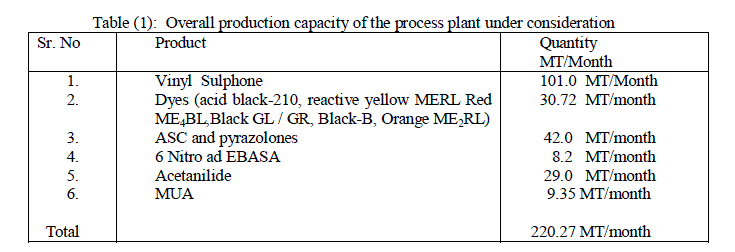 |
 |
| The manufacturing unit uses Incinerator technology so we have taken last six month data presented in Table 4 and also daily basis data for single month which is presented in Table5 for the basis of calculation for this paper. |
 |
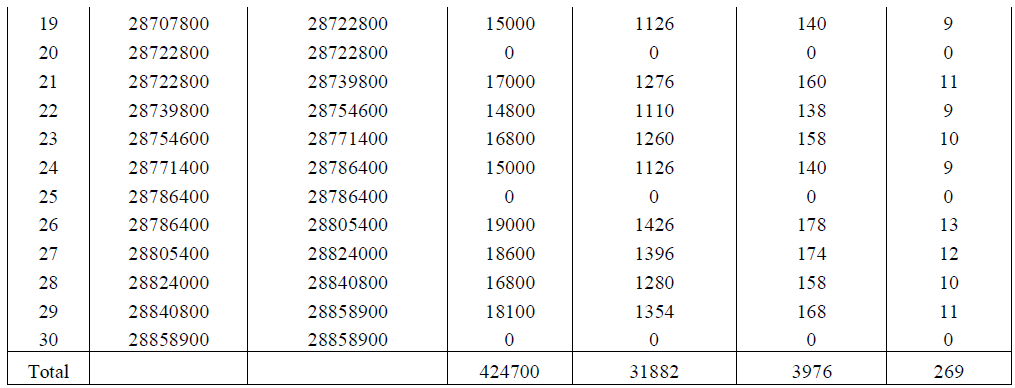 |
CALCULATIONS |
| Calculation is done based on average monthly waste generation so here cost equation is derived by considering fixed & variable cost which is presented in Table 6 |
 |
 |
RESULTS AND DISCUSSIONS |
| After formulating the cost equation of each technology the data has been generated for various capacities by using GAMS code and Results are presented in table7. Here the prime objective is to get the most economical technology and the Objective function is: |
 |
| Where: Set j [ MEE, INC, ECT ] and |
| Parameter aj [ INC 150000, MEE 200000, ECT 150000 ] |
| bj [ INC 2500, MEE 850, ECT 3200 ] |
| cj [ INC 175000, MEE 500000, ECT 125000 ] |
| Here x is capacity of waste generation of a plant and its value is considered from 100 to 1200 Kilo Liters. Where Yj is considered as binary variables and their constraint equation is |
 |
| All the results of various equations and MINLP model presented in this section were obtained using different GAMS solver: GAMS Rev 233 WIN-VIS 23.3.3 x86/MS Windows. The results presented in this paper of cost comparison for all three technologies at different waste water treated are shown in Graph no 1, Cost comparison of all three technologies as a cost per liter of waste water treatment is shown in Graph 2 while Graph 3 represents the solid waste generation for all three technologies at different capacities of waste water. |
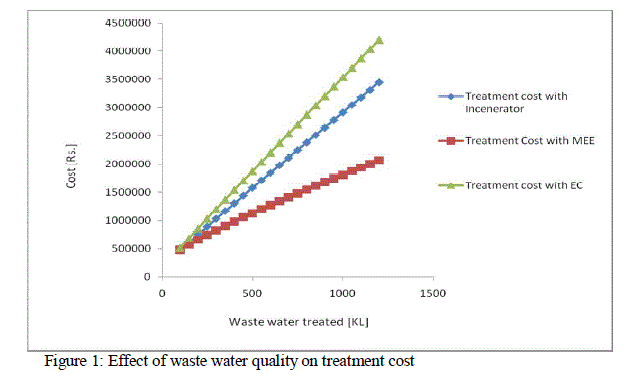 |
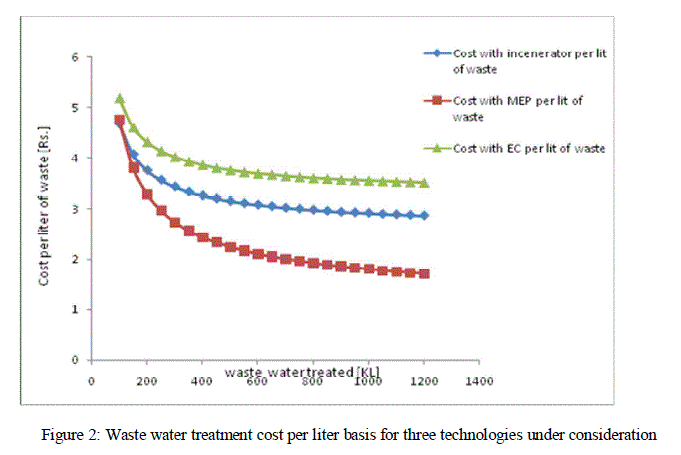 |
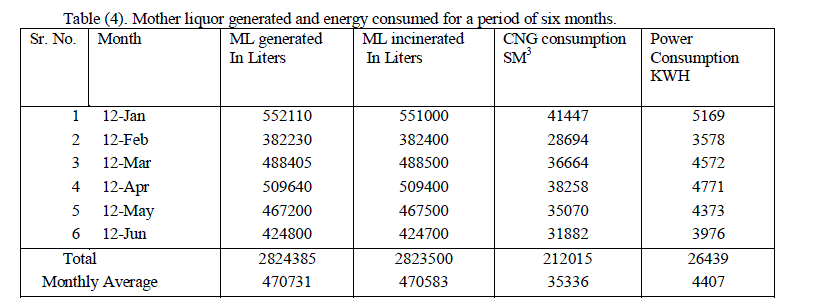 |
| Table (8). Salt is generated through Multiple effect evaporator. It is sold as by product simentenously the waste heat recovery and condensate recovered are shown in Table 9. |
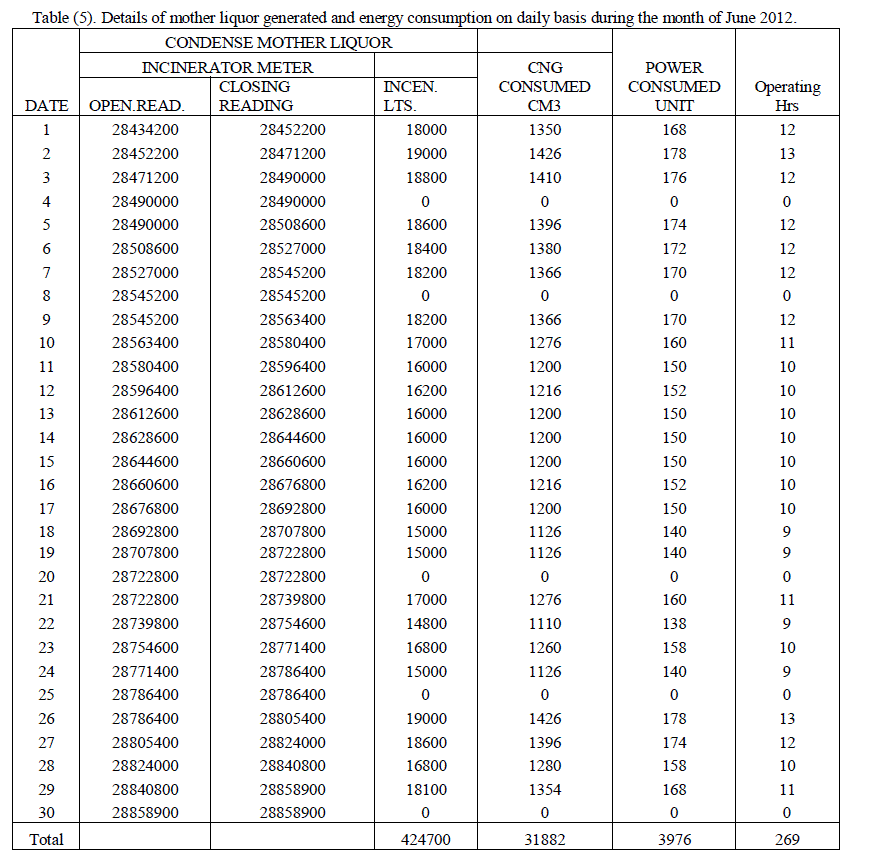 |
| Three different waste water treatment methods have been discussed for Vinyl Sulfone product. All three technologies are proven to bring down the COD level from 1-1.5 lakh ppm to 250 to 300 ppm. The monthly data has been considered as the base for the calculation so for the treatment of 450,000 Liters of waste Total cost with Multiple effects evaporator is Rs. 10,51,870/-(Per liter cost Rs.2.34), total cost with Incinerator = Rs.14,39,280/-(Per liter cost Rs.3.2), and with Electro chemical treatment is Rs. 17,07,343/-(Per liter cost Rs.3.79), so with MEE cost is significant low compare to other two technologies. Electro chemical treatment has wide variety of advantages because of its simplicity and convenience in operation same way Incinerator is fairly simple equipment which can achieve substantial removal efficiencies. It is quite effective in lowering contamination and hence reduces the pollutant because of burning of most of the gases but major drawback of both of them are the waste disposal so for the treatment of 450,000 Liters of waste total waste with Multiple effect is 5,091 kg, total waste with Incinerator is 36,000 kg and total waste with Electro chemical is 22500 kg. More than that MEE allows the recovery of salt, condensate and waste heat so for the treatment of 450,000 Liters of waste total salt recover is 90,000 kg, total condensate recovery is 36,000 kg and total waste heat recovery is 22500 . Again the salt is sold as by product @ 8 Rs./Kg which lead the recovery of Rs.7,20,000/-. |
COST COMPARISON OF ALL THREE TECHNOLOGIES BY USING TIME VALUE OF MONEY |
| A perpetuity is a type of an annuity for which the regular payments continue for indefinite time. This form of annuity allows engineers, to evaluate a total equipment or any other asset cost for a conditions which allow the asset to be exchanged perpetually with a negligible effect of inflation or deflation. Capitalized costs technique is ideally suited to comparing various alternative: |
| K = Cv + CR /[(l + i )n - 1] |
| K = The capitalized cost is principally considered as the original value of the equipment and the present cost of the renewable perpetuity |
| Cv = Initial Cost CR = Replacement Cost = Cv-Vs Vs = Salvage Value |
| i = Rate of Interest n = Service life |
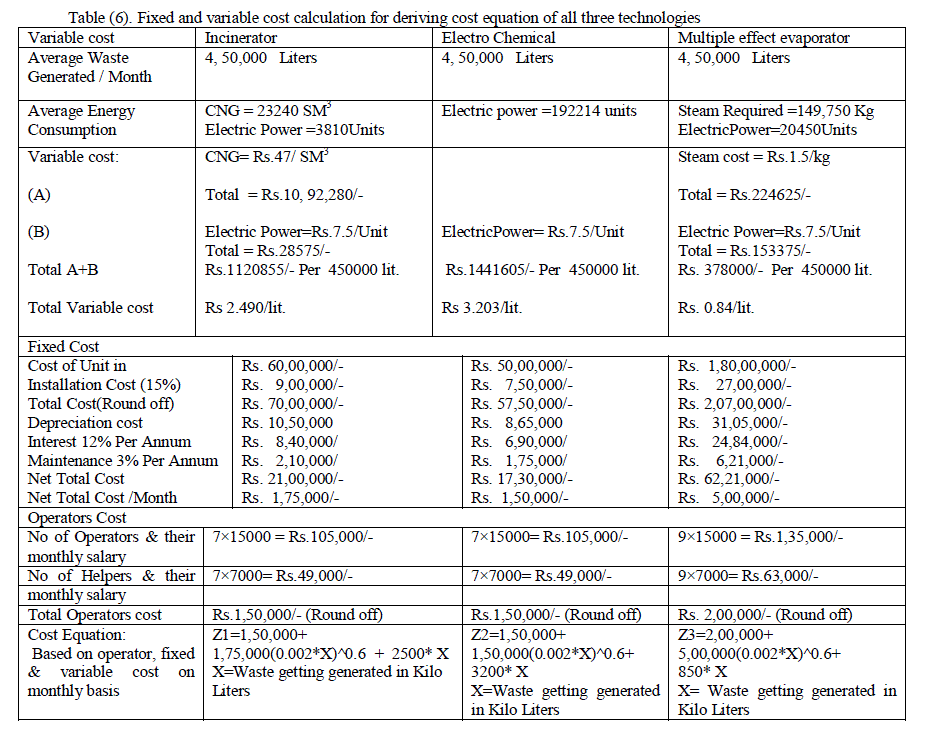 |
PAYBACK PERIOD |
| In case of Multiple effect evaporator salt is sold as by product @ 8 Rs./Kg which lead the recovery of Rs.7,20,000/-. Per month |
| Mathematically: Annuity is the sum of all the accumulated amounts from each payment: |
 |
| R =Uniform Monthly Amount =7,20,000/- |
| S = Total compound amount = Vs Original Amount = 2,07,00000/- |
| i = Rate of interest Annually = 10% |
| n = Payback period = 25.8 Approximate =26 months |
CONCLUSION |
| Comparative study of Multiple Effect Evaporator (MEE), Incinerator, Electrochemical Treatment (ECT) for treating Dyes and Dyes Intermediates waste is conducted. MEE was found to be more economical and environmentally friendly technology. It was also found that the solids generated from MEE can be sold as by product which can lead the recovery of initial Cost of MEE in just 26 months. Moreover, incinerator ash and ECT sludge disposal problems can be avoided by using MEE infact condensate water can be recycled/ reused. The advantages of selecting MEE over Incinerator, Electrochemical Treatment (ECT) are successfully demonstrated with the help of an industrial case study of manufacturing unit producing Dyes and Dyes Intermediates located in GIDC Ahmadabad. |
ANNEXURE I |
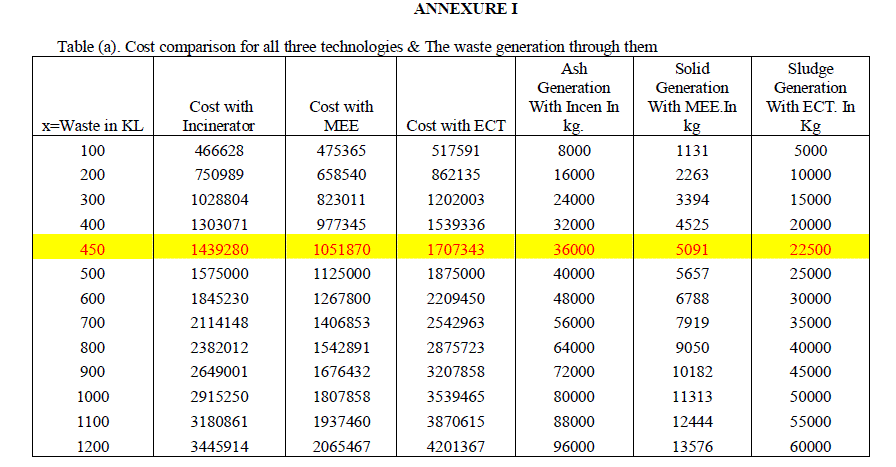 |
References |
|